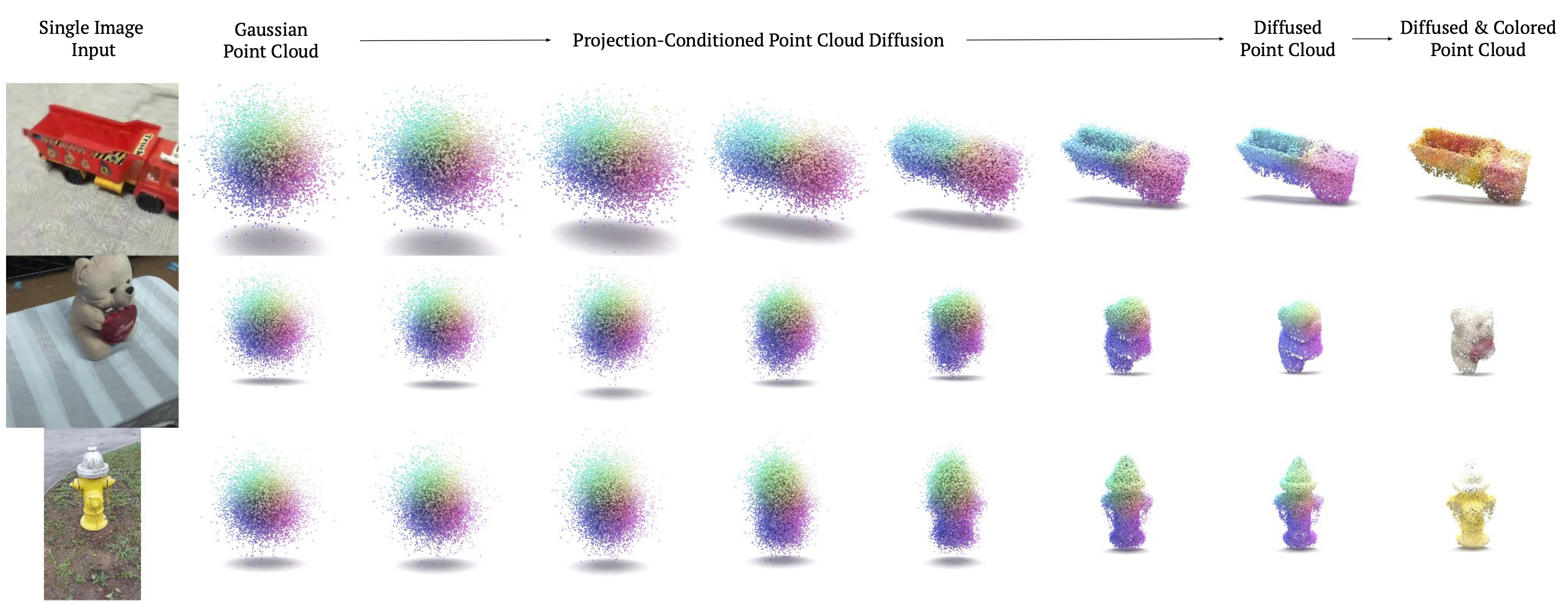This repository uses PyTorch3D for most 3D operations. It uses Hydra for configuration, and the config is located at config/structured.py. The entrypoints for training are main.py for the point cloud diffusion model and main_coloring.py for the point cloud coloring model. There are shared utilities in diffusion_utils.py and training_utils.py. The data is Co3Dv2.
I substantially refactored the repository for the public release to use the diffusers library from HuggingFace. As a results, most of the code is different from the original code used for the paper. Only the Co3Dv2 dataset is implemented in this version of this code, but it should be easy to run on other datasets if you need to.
If you have any questions or contributions, feel free to leave an issue or a pull request.
Reconstructing the 3D shape of an object from a single RGB image is a long-standing and highly challenging problem in computer vision. In this paper, we propose a novel method for single-image 3D reconstruction which generates a sparse point cloud via a conditional denoising diffusion process. Our method takes as input a single RGB image along with its camera pose and gradually denoises a set of 3D points, whose positions are initially sampled randomly from a three-dimensional Gaussian distribution, into the shape of an object. The key to our method is a geometrically-consistent conditioning process which we call projection conditioning: at each step in the diffusion process, we project local image features onto the partially-denoised point cloud from the given camera pose. This projection conditioning process enables us to generate high-resolution sparse geometries that are well-aligned with the input image, and can additionally be used to predict point colors after shape reconstruction. Moreover, due to the probabilistic nature of the diffusion process, our method is naturally capable of generating multiple different shapes consistent with a single input image. In contrast to prior work, our approach not only performs well on synthetic benchmarks, but also gives large qualitative improvements on complex real-world data.
Dependencies may be installed with pip:
pip install -r requirements.txtPyTorch and PyTorch3D are not included in requirements.txt because that sometimes messes up conda installations by trying to re-install PyTorch using pip. I assume you've already installed these by yourself. If not, you can use a command such as:
mamba install pytorch torchvision pytorch-cuda=11.7 pytorch3d -c pytorch -c nvidia -c pytorch3dFor our data, we use Co3Dv2. Full information about the dataset is provided on the GitHub page.
We train on individual categories, so you can just download one category or a subset of the categories (for example hydrants or teddy bears).
Then you can set the environment variable CO3DV2_DATASET_ROOT to the dataset root:
export CO3DV2_DATASET_ROOT="your_dataset_root_folder"The config is in config/structured.py.
You can specify your job mode using run.job=train, run.job=train_coloring, run.job=sample, or run.job=sample_coloring. By default, the mode is set to train.
An example training command is:
python main.py dataset.category=hydrant dataloader.batch_size=24 dataloader.num_workers=8 run.vis_before_training=True run.val_before_training=True run.name=train__hydrant__ebs_24To run multiple jobs in parallel on a SLURM cluster, you can use a script such as:
python scripts/example-slurm.py --partition ${PARTITION_NAME} --submitSeparately, you can train a coloring model to predict the color of points with fixed locations in 3D space.
An example command is:
python main_coloring.py run.job=train_coloing model=coloring_model run.mixed_precision=no dataset.category=hydrant dataloader.batch_size=24 run.max_steps=20_000 run.coloring_training_noise_std=0.1 run.name=train_coloring__hydrant__ebs_24For sampling point clouds, use run.job=sample.
For example:
python main.py run.job=sample dataloader.batch_size=16 dataloader.num_workers=6 dataset.category=hydrant checkpoint.resume="/path/to/checkpoint/like/train__hydrant__ebs_24/2022-11-01--17-04-36/checkpoint-latest.pth" run.name=sample__hydrant__ebs_24Results will be saved to your output directory.
Afterwards, you can predict colors using the point clouds obtained from the sampling procedure above, specifying them with the argument run.coloring_sample_dir.
For example:
python main_coloring.py run.job=sample_coloing dataset.category=hydrant dataloader.batch_size=8 model=coloring_model checkpoint.resume="/path/to/coloring/model/checkpoint-latest.pth" run.coloring_sample_dir="/path/to/sample/dir/like/sample__hydrant__ebs_24/2022-09-22--18-03-20/sample/" run.name=sample_coloring__hydrant__ebs_24Side note: although this is called "sample_coloring" in the code, it is not really doing any sampling because the coloring model is deterministic.
You can download example checkpoints here:
# Downloads checkpoint and logs (1.2G)
bash ./scripts/download-example-logs-and-checkpoints.sh
# Downloads visualizations over the course of training, as an example. Since
# these are large (3.5G), we have made them a separate download.
bash ./scripts/download-example-vis.shThese are newly-trained models with this codebase. We can train and upload models for other categories as well if you would like; just let us know.
(1) If you get an error of the form Error building extension '_pvcnn_backend', make sure you have installed gcc and g++. Then check the path in model/pvcnn/modules/functional/backend.py and edit it to your desired location.
(2) I believe PyTorch3D has some large changes recently and it is possible some of their code is now broken. I am using version 0.7.3 with a patch on line 634 of pytorch3d/implicitron/dataset/frame_data.py.
image_rgb = torch.from_numpy(load_image(self._local_path(path)))(3) You may also have to patch the accelerate library in order to properly batch the FrameData objects from PyTorch3D. To fix this I replaced the following lines in accelerate/utils/operations.py (L91-99)
elif isinstance(data, Mapping):
return type(data)(
{
k: recursively_apply(
func, v, *args, test_type=test_type, error_on_other_type=error_on_other_type, **kwargs
)
for k, v in data.items()
}
)with the following lines
elif isinstance(data, Mapping):
from pytorch3d.implicitron.dataset.data_loader_map_provider import FrameData
if isinstance(data, (FrameData)):
return type(data)(
**{
k: recursively_apply(
func, v, *args, test_type=test_type, error_on_other_type=error_on_other_type, **kwargs
)
for k, v in data.items()
}
)
else:
return type(data)(
{
k: recursively_apply(
func, v, *args, test_type=test_type, error_on_other_type=error_on_other_type, **kwargs
)
for k, v in data.items()
}
)- The PyTorch3D library.
- The diffusers library.
- The Co3D and Co3Dv2 datasets.
- Our funding: Luke Melas-Kyriazi is supported by the Rhodes Trust. Andrea Vedaldi and Christian Rupprecht are supported by ERC-UNION-CoG-101001212. Christian Rupprecht is also supported by VisualAI EP/T028572/1.
@misc{melaskyriazi2023projection,
doi = {10.48550/ARXIV.2302.10668},
url = {https://arxiv.org/abs/2302.10668},
author = {Melas-Kyriazi, Luke and Rupprecht, Christian and Vedaldi, Andrea},
title = {PC^2 Projection-Conditioned Point Cloud Diffusion for Single-Image 3D Reconstruction},
publisher = {arXiv},
year = {2023},
}




